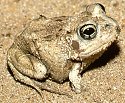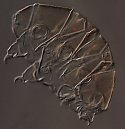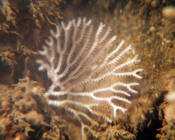Porifera (sponges)
|
|
Ctenophora
(comb-jellies)
|
|
|
Cnidaria
(jellyfish,
sea anemones,
sea fans,
soft corals,
hard corals)
The unique feature of the Cnidaria is
that they have stinging cells, called nematocysts. Each of these cells
contains a thread-like sting that is discharged in attack or defense (if you
have been stung by a bluebottle while swimming at the beach, you will know
all about this). Cnidaria come in two main forms: polyps, that usually stays
in one place (e.g.
sea anemones), or medusae that have an umbrella shape and float or swim
around in the water (e.g.
jellyfish). Bluebottles and their relatives (Siphonophora)
are unusual in that each of them is basically a colony of floating polyps,
one of which is inflated to form the float. So not all polyps are sedentary.
Some of the most important members of the Cnidaria are the
corals
that, in association with symbiotic algae, are able to lay down calcium
carbonate and in this way build whole islands that people now live on.
|
|
|
Placozoa
Trichoplax adhaerens, an amoeba-like marine animal
about half a centimeter long, is the sole species known from this phylum. |
|
Bilateria
|
|
| |
Deuterostomia
|
|
| |
|
Chordata
(vertebrates and relatives, including fish,
mammals, birds,
reptiles and
amphibians).
Have a dorsal nerve cord and a notocord (that becomes
the vertebral column in vertebrates). |
 |
| |
|
Ambulacraria
|
|
| |
|
|
Hemichordata
Marine organisms such as acorn worms. |
|
| |
|
|
Echinodermata (starfish, sea urchins, sea cucumbers, etc.)
|
|
| |
Ecdysozoa
|
|
| |
|
Gastrotricha
About 430
species known, all microscopic. |
|
| |
|
Introverta |
|
| |
|
|
Nematoida
|
|
| |
|
|
|
Nematomorpha (horsehair worms)
About 320 species known. |
|
| |
|
|
|
Nematoda
(nematodes or roundworms)
About 12000 species known, but an estimated 200000+ species extant, mostly
microscopic. Considered the second most diverse animal phylum after the
arthropods. |
|
| |
|
|
Cephalorhyncha (= Scalidophora) |
|
| |
|
|
|
Priapula (priapulid worms)
Sixteen species known, about half microscopic. |
|
| |
|
|
|
Scalidorhyncha |
|
| |
|
|
|
|
Kinorhyncha (mud dragons)
About 150 species known, all microscopic. |
|
| |
|
|
|
|
Loricifera (loriciferans) |
|
| |
|
Panarthropoda |
|
| |
|
|
Onychophora (peripatus) |
 |
| |
|
|
Tritocerebra |
|
| |
|
|
|
Tardigrada (water bears) |
 |
| |
|
|
|
Arthropoda
(insects, spiders, scorpions, crustaceans, centipedes, millipedes) |
|
| |
Lophotrochozoa
|
|
| |
|
Platyhelminthes (flatworms,
tapeworms) |
|
| |
|
Rotifera (rotifers or "wheel animalcules")
About 1500 species known, all microscopic. |
|
| |
|
Cycliophora
|
|
| |
|
Entoprocta
|
|
| |
|
Bryozoa
[= Ectoprocta]
|
 |
| |
|
Annelida (segmented worms, including
earthworms and leaches)
|
|
| |
|
Nemertea (ribbon worms)
Marine worms that in some species can reach 30 m in length! Synonyms:
Nemertini or Nemertina. |
|
| |
|
Sipunculida (peanut worms)
[= Sipuncula]
Marine. |
|
| |
|
Mollusca (snails, muscles, squid, etc.) |
|
| |
|
Echiura (spoon worms and innkeepers)
Marine. Once placed with the phylum Annelida. |
|
| |
|
Siboglinidae (beard worms)
[= Pogonophora, Vestimentifera]]
Marine worms living in
tubes. Some giant species, 1.5 m long have been found around warm water
vents in the Pacific Ocean. Siboglinidae has been placed previously under
the Annelida. |
|
| |
|
Phoronida
|
|
| |
|
Brachiopoda (lamp shells)
Look superficially like clams in that they have a similar shaped shell
but they are not molluscs. |
|
